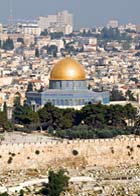East Jerusalem

During Vice President Joseph Biden's visit to Israel last week, a routine bureaucratic approval of additional dwellings for ultra-Orthodox Jews was leaked to the media, thereby setting off a crisis in relations between the two countries. The neighborhood in question, Ramat Shlomo, is said to stand in Arab East Jerusalem. But what and where is East Jerusalem?
The term is an artificial construct, and a misnomer. Jerusalem is a city built on hills, embedded on a mountain ridge; Samaria lies to the north, Judea to the south. The city has no grid system—no Fifth Avenue to divide the east and west sides. Until Israel's victory in the June 1967 Six Day War, parts of Jerusalem were artificially separated along the armistice lines resulting from Israel's 1948 war of independence. North, south, and east Jerusalem lay under control of the Hashemite Kingdom of Jordan.
By June 28, 1967 the barriers had been dismantled. The city's boundaries were dramatically expanded beyond the six square kilometers of the Jordanian municipality, including the Old City, to embrace the Mount of Olives with its Jewish cemetery, Mount Scopus and the pre-state campus of the Hebrew University, and 28 nearby Arab villages. All were incorporated into Israel proper. Today the city's Palestinian Arabs carry ordinary blue Israeli ID cards and make full use of universal health coverage as well as other social benefits. They also enjoy the right to vote in municipal elections, but so far have opted to boycott political participation.
When the city was first liberated, former premier David Ben-Gurion called for a national effort to settle the empty spaces of metropolitan Jerusalem. Since then, international opposition notwithstanding, all Israeli governments have worked to solidify control of the city by constructing a sequence of strategically placed residential neighborhoods: Gilo and Har Homah in the south; East Talpiot in the east; Ramat Eshkol, French Hill, Pisgat Ze'ev, Neve Yaakov in the north; and Ramot on the northern flank of the Jerusalem-Tel Aviv highway. Although some Jordanian government lands and some private property were confiscated, most of the strategic sites chosen were on barren hills. Only in recent years have small numbers of ideological settlers moved into densely populated Arab neighborhoods. As for Ramat Shlomo, the neighborhood at the center of the latest flap, it lies to the west of Ramot—that is, in northern Jerusalem.
And where does the United States stand? Among those bodies opposing Israel's 1967 annexation was the State Department. To this day, the American consulate is housed in an antiquated compound on Nablus Road in east Jerusalem, while a separate facility in the center of the city serves as the consul general's residence. (A newly built consulate in west Jerusalem stands empty.) The embassy is in Tel Aviv, since Washington does not recognize Israel's sovereignty over any part of Jerusalem—west, east, north, or south.
Yet on June 19, 1967, President Lyndon Johnson declared: "No one wishes to see the Holy City again divided." Today, any fair-minded visitor would have to acknowledge that Jerusalem is a mosaic of neighborhoods built on hills and in valleys where Jews and Arabs live in proximity and share common spaces. There may come a time when a borough arrangement will permit them to administer the city conjointly; some Israeli governments have also offered parts of the city to a Palestinian state. Meanwhile, to imagine Jerusalem divisible along east-west lines bespeaks a profound ignorance of both history and political geography.
Comments are closed for this article.




